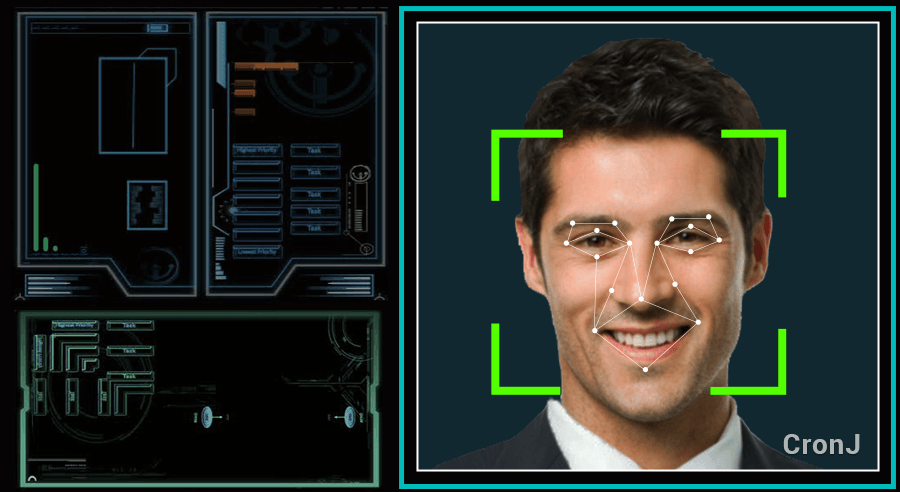Face Recognition
A facial recognition system is a technology capable of identifying or verifying a person from a digital image or a video frame from a video source. There are multiple methods in which facial recognition systems work, but in general, they work by comparing selected facial features from given image with faces within a database.
Here we will follow the following steps:
- Create a dataset of one person's face, say 100 samples.
- Use somple suitable Machine learning algorithms to train model.
- Use trained model for recognition face.
Let’s look at an code :
Create Training Data
# Import the modules
import cv2
import numpy as np
# Load HAAR face classifier
face_classifier = cv2.CascadeClassifier( 'haarcascade_frontalface_default.xml')
# Function to extract face from frame
def face_extractor(img):
# Function detects faces and returns the cropped face
# If no face detected, it returns the input image
gray = cv2.cvtColor( img, cv2.COLOR_BGR2GRAY)
faces = face_classifier.detectMultiScale( gray, 1.3, 5)
if faces is ():
return None
# Crop all faces found
for (x,y,w,h) in faces:
cropped_face = img[y:y+h, x:x+w]
return cropped_face
# Initialize Webcam
cap = cv2.VideoCapture(0)
count = 0
# Collect 100 samples of your face from webcam input
while True:
ret, frame = cap.read()
# If face is found in frame
if face_extractor(frame) is not None:
count += 1
face = cv2.resize(face_extractor(frame), (200, 200))
face = cv2.cvtColor(face, cv2.COLOR_BGR2GRAY)
# Save file in specified directory with unique name
file_name_path = 'face/' + str(count) + '.jpg'
cv2.imwrite(file_name_path, face)
# Put count on images and display live count
cv2.putText(face, str(count), (50, 50), cv2.FONT_HERSHEY_COMPLEX, 1, (0,255,0), 2)
cv2.imshow('Face Cropper', face)
else:
print("Face not found")
pass
if cv2.waitKey(1) == 13 or count == 100: #13 is the Enter Key
break
# After collecting samples, Release and destroyAllWindows
cap.release()
cv2.destroyAllWindows()
print("Collecting Samples Complete")
Train Model
# Import the modules
import cv2
import numpy as np
from os import listdir
import pickle
from os.path import isfile, join
# Get the training data we previously made
data_path = 'face/'
onlyfiles = [f for f in listdir(data_path) if isfile(join(data_path, f))]
# Create arrays for training data and labels
Training_Data, Labels = [], []
# Open training images in our datapath
# Create a numpy array for training data
for i, files in enumerate(onlyfiles):
image_path = data_path + onlyfiles[i]
images = cv2.imread(image_path, cv2.IMREAD_GRAYSCALE)
Training_Data.append( np.asarray( images, dtype=np.uint8))
Labels.append(i)
# Create a numpy array for both training data and labels
Labels = np.asarray(Labels, dtype=np.int32)
# Initialize facial recognizer
model = cv2.face.LBPHFaceRecognizer_create()
# NOTE: For OpenCV 3.0 use cv2.face.createLBPHFaceRecognizer()
Training_Data), np.asarray(Labels))
print("Model trained sucessefully")
# Let's train our model
model.train(np.asarray( Training_Data), np.asarray(Labels))
print("Model trained sucessefully")
Run Our Facial Recognition
# Import the modules
import cv2
import numpy as np
import time
# Load HAAR face classifier
face_classifier = cv2.CascadeClassifier( 'haarcascade_frontalface_default.xml')
# Function to detect face
def face_detector(img, size=0.5):
# Convert image to grayscale
gray = cv2.cvtColor(img,cv2.COLOR_BGR2GRAY)
faces = face_classifier.detectMultiScale( gray, 1.3, 5)
# If face not found return blank region
if faces is ():
return img, []
# Obtain Region of face
for (x,y,w,h) in faces:
cv2.rectangle(img, (x,y), (x+w,y+h), (0,255,255),2)
roi = img[y:y+h, x:x+w]
roi = cv2.resize(roi, (200, 200))
return img, roi
# Open Webcam
cap = cv2.VideoCapture(0)
while True:
ret, frame = cap.read()
image, face = face_detector(frame)
try:
face = cv2.cvtColor(face, cv2.COLOR_BGR2GRAY)
# Pass face to prediction model
# "results" comprises of a tuple containing the label and the confidence value
results = model.predict(face)
# Tell about the confidence of user.
if results[1] < 500:
confidence = int( 100 * (1 - (results[1])/400) )
display_string = str(confidence) + '% Confident it is User'
cv2.putText(image, display_string, (100, 120), cv2.FONT_HERSHEY_COMPLEX, 1, (255,120,150), 2)
# If confidence is greater than 90 then the face will be recognized.
if confidence > 90:
cv2.putText(image, "Unlocked", (250, 450), cv2.FONT_HERSHEY_COMPLEX, 1, (0,255,0), 2)
cv2.imshow('Face Recognition', image )
# If confidence is less than 90 then the face will not be recognized.
else:
cv2.putText(image, "Locked", (250, 450), cv2.FONT_HERSHEY_COMPLEX, 1, (0,0,255), 2)
cv2.imshow('Face Recognition', image )
# Raise exception in case, no image is found
except:
cv2.putText(image, "No Face Found", (220, 120) , cv2.FONT_HERSHEY_COMPLEX, 1, (0,0,255), 2)
cv2.putText(image, "Locked", (250, 450), cv2.FONT_HERSHEY_COMPLEX, 1, (0,0,255), 2)
cv2.imshow('Face Recognition', image )
pass
# Breaks loop when enter is pressed
if cv2.waitKey(1) == 13: #13 is the Enter Key
break
# Release and destroyAllWindows
cap.release()
cv2.destroyAllWindows()
Note : Train Model and Run Our Facial Recognition should be written on same file.
Our Output image will look like this:




